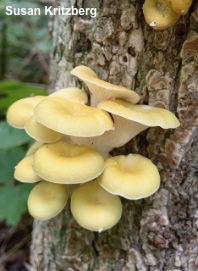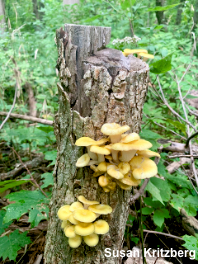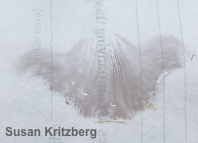| Major Groups > Gilled Mushrooms > Pale-Spored > Pleurotus citrinopileatus |

|
[ Basidiomycota > Agaricales > Pleurotaceae > Pleurotus . . . ] Pleurotus citrinopileatus by Michael Kuo, 25 October 2024 Pleurotus citrinopileatus is apparently an example of a species that has "escaped" from cultivation and has begun to naturalize itself in eastern North America. It represents a cultivated, yellow "oyster mushroom" whose natural origins are unclear (although it was first described in eastern Asia and may originate there). Distinguishing features for Pleurotus citrinopileatus include its clustered growth on the deadwood of hardwoods, the bright yellow caps with a shallow central depression, and the deeply decurrent gills, which run almost entirely down the length of the stem. Yellow versions of Armillaria tabescens are not uncommon, but the gills are not as deeply decurrent—while Gerronema strombodes, also similar, has brown fibrils in its cap. Pleurotus cornucopioides var. citrinopileatus is a synonym. Thanks to Susan Kritzberg for documenting, collecting, and preserving Pleurotus citrinopileatus for study; her collection is deposited in The Herbarium of Michael Kuo. Description: Ecology: Saprobic; growing in clusters on the deadwood of hardwoods—especially elms; summer and fall; originally described from southeastern Russia (Singer 1943); also found in China and in western Europe; in North America distributed from Iowa to New York, through the Great Lakes states. The illustrated and described collections are from Illinois and Ohio. Cap: 3–8 cm across; convex, with a shallow central depression; moist when young and fresh; bald; bright to medium yellow, with a whitish margin; margin at first a little incurved, becoming arched with age. Gills: Running down the stem; distant or nearly so; whitish; short-gills frequent; whitish. Stem: 2–8 x 1–2 cm; equal, or tapered slightly downward; central or slightly off-center; covered with the gills nearly to the base; whitish to grayish; finely mealy below the gills; fused with other stems at the base, in a whitish mass of tissue. Flesh: White; unchanging when sliced. Odor: Strong, sweetish; odor of rehydrated herbarium material pungent, subspermatic. Spore Print: Pale lilac. Microscopic Features: Spores 5–10 x 2.5–4 µm; elongated-ellipsoid to subamygdaliform or nearly allantoid; smooth; hyaline in KOH; inamyloid. Basidia 30–40 x 4–6 µm; clavate; 4-sterigmate. Cystidia not found. Pileipellis a tightly packed cutis; elements 2.5–7.5 µm wide, smooth, hyaline to yellowish in KOH; clamp connections present. REFERENCES: R. Singer, 1943. (Ohira, 1990; Zervakis & Balis, 1996; Bao et al., 2004; Rosnina et al., 2016; Bruce, 2018.) Herb. Kuo 09032101, 05252403. This site contains no information about the edibility or toxicity of mushrooms. |
© MushroomExpert.Com |
|
Cite this page as: Kuo, M. (2024, October). Pleurotus citrinopileatus. Retrieved from the MushroomExpert.Com Web site: http://www.mushroomexpert.com/pleurotus_citrinopileatus.html |





